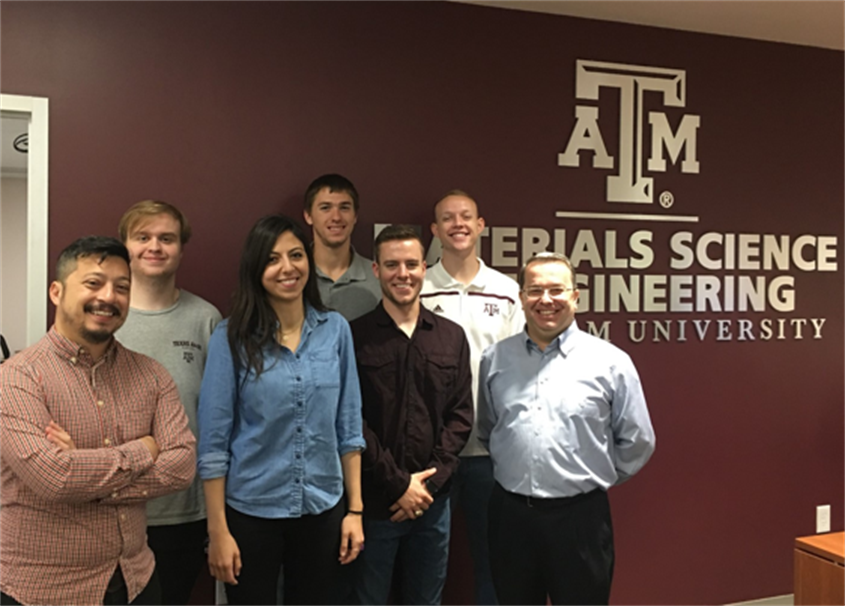Tasked with designing a new material that can transform its shape at very low temperatures, a team of undergraduate and graduate students in the Texas A&M University College of Engineering went above and beyond the competition’s requirements and conquered the Consortium for the Advancement of Shape Memory Alloy Research and Technology’s (CASMART) challenge to develop new materials and hardware using shape memory alloy technology.
Under the direction of Dr. Ibrahim Karaman, head of the Department of Materials Science and Engineering, the team, consisted of William Trehern, Nathan Hite, Nathan Malone, Ben Loveall, Hande Ozcan and Brian Franco. For the challenge they designed a material for an expandable habitat in space application.

“We had one semester to design a material,” said Ozcan, graduate student advisor for the team. “Specifically, we were looking for some alloy compositions that could show giant shape change at -150 degrees Celsius.”
The material designed by the team, who call themselves the “Space Cowboys,” was to be used for an expandable space habitat that can be deployed for deep space exploration. To do so, the material must be able to begin transforming at -150 degrees Celsius during cooling and heating, or under mechanical stress.
“Shape memory alloys are a multifunctional material that goes through a phase transformation from austenite to martensite,” Ozcan said. “Unlike other materials, shape memory alloys can recover large deformation and go back to their original shape. That’s why they are called smart materials.”
After an extensive review of literature and using prior experiences of the research group led by Karaman, the Space Cowboys began working and melting 40-50 metals with various compositions to hone in on the perfect properties, testing their ability to actuate at low temperatures.
“Basically, what we try to do is conduct different heat treatments and experiments to improve microstructure and mechanical properties,” Ozcan said. “We play with processing techniques and change the microstructure so that we can achieve our desired mechanical property.”
After melting the materials the team must decide how to proceed.
“Do we want to do some type of hot rolling or do we want to skip that completely and go to different heat treatments and try to manipulate the microstructure?” Trehern said. “From there we cut out a few samples and began testing on resistivity versus temperature to show us shape memory effect at very low temperatures.”
One of the biggest obstacles to overcome was finding a way to test these alloys at very low temperatures. Since there are very few machines that are capable of testing materials at such low temperatures, they used a machine that uses liquid helium to cool down the sample and test .
“In the end we chose to investigate four different materials: nickel-titanium, nickel-titanium-iron, an iron based alloy and copper-based alloys” Trehern said. “To determine the amount of transformation in these materials, we designed and developed a unique testing apparatus that could reach these ultra-low temperatures. Using this setup we were able to show that several of our materials were able to surpass all the requirements of the challenge.”
At the end of the semester, the team set off to compete at the Shape Memories and Superelastic Technologies 2017 conference where they presented their poster highlighting their discoveries for CASMART. Three team members competed against 10 other teams from universities all over the nation. The Space Cowboys impressed judges and competitors by presenting results for more than just one alloy, earning first place overall.
As for the creative team name, the team turned to music for inspiration to set them apart from the other competitors.
“Everyone else had these names that were so typical for materials science, so we figured we could add some comic relief to the competition, as well as represent the state of Texas,” Ozcan said. “We began listening to different songs to get inspiration and found “The Joker” by the Steve Miller Band, in which the lyrics include the phrase ‘space cowboy.’”
Upon the completion of the competition, Trehern decided to pursue a doctoral degree in materials science due to his experiences with CASMART.
“The competition had such a positive impact on William, he decided to stay as a Ph.D. student with Dr. Karaman,” Ozcan said. “Now he is working on a continuation of this project with NASA and extreme temperature shape memory alloys.”